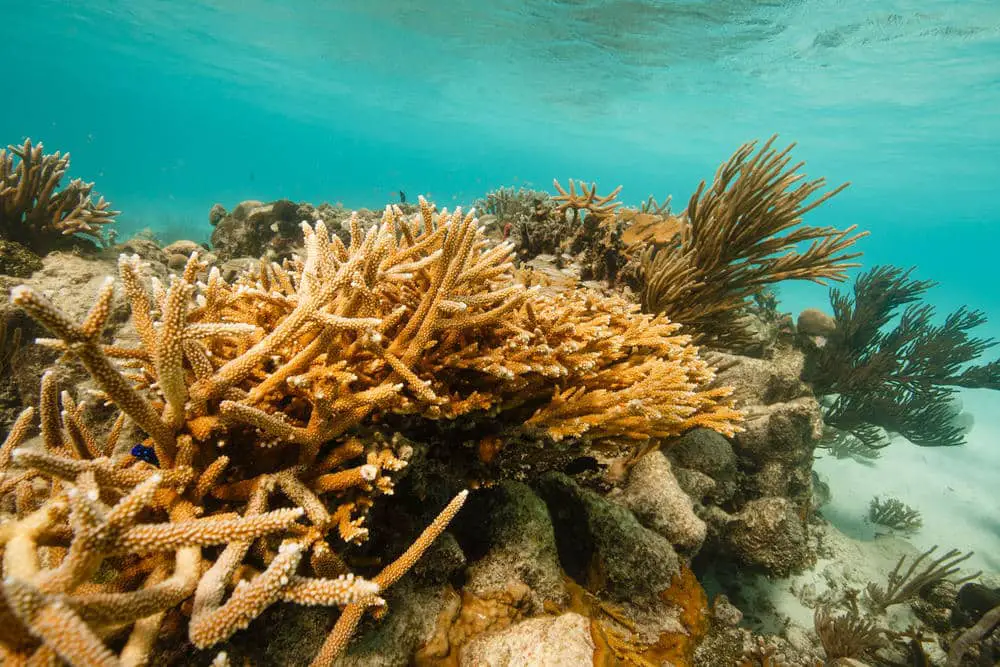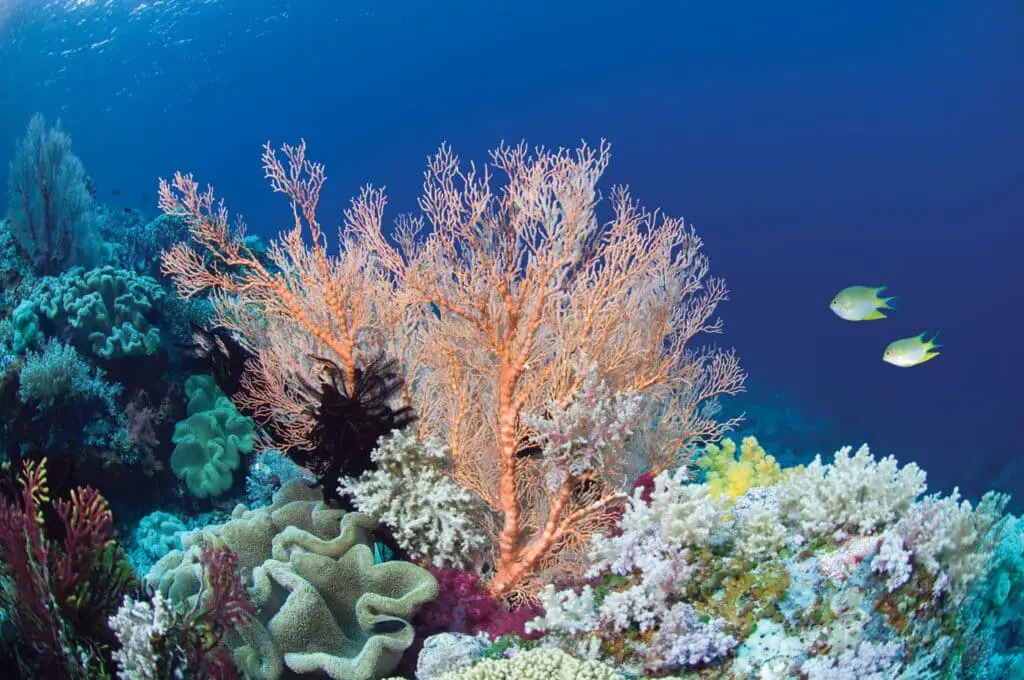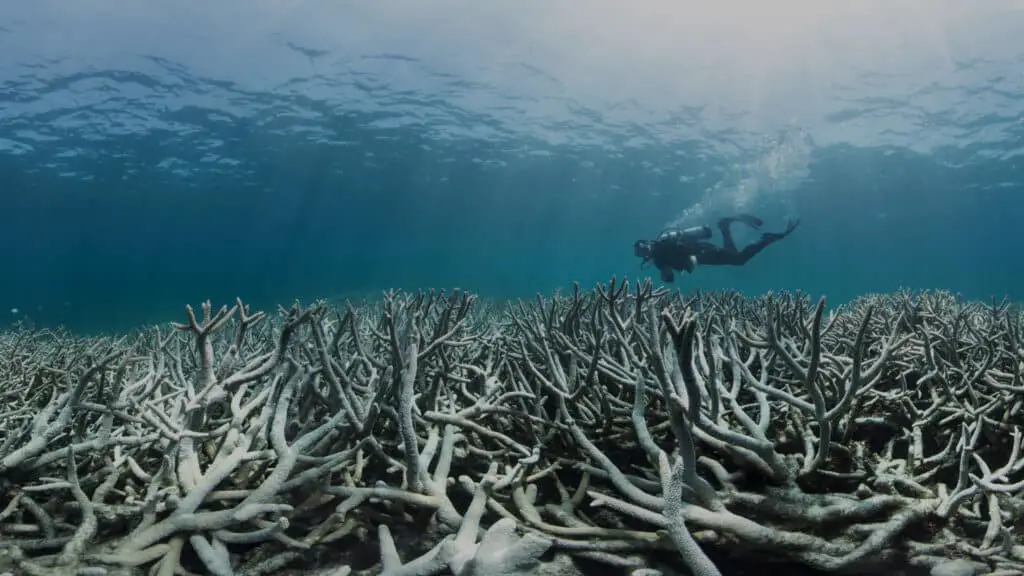How Does Global Climate Change Affect Coral Reefs

Introduction
How Does Global Climate Change Affect Coral Reefs: Coral reefs are often referred to as the “rainforests of the sea,” showcasing a stunning diversity of marine life and providing essential ecosystem services to both coastal communities and the broader planet. Yet, these remarkable underwater ecosystems are facing an existential threat – global climate change.
Climate change, driven primarily by human activities such as the burning of fossil fuels and deforestation, has unleashed a cascade of environmental consequences. We will explore the intricate and alarming ways in which global climate change affects these delicate and crucial ecosystems.
At the heart of the issue lies rising sea temperatures. The Earth’s oceans absorb much of the excess heat generated by the increase in greenhouse gases, causing water temperatures to rise. Corals, which have a symbiotic relationship with photosynthetic algae called zooxanthellae, are highly sensitive to even slight changes in temperature. When stressed by elevated water temperatures, corals expel these vital algae, resulting in coral bleaching, a phenomenon that leaves them vulnerable and often leads to their death.

What coral reefs are most affected by climate change?
Climate change is increasing the frequency and intensity of severe weather events. Coastal regions like the Great Barrier Reef are particularly exposed to damaging cyclones, flooding and storms.
Coral reefs around the world are facing the adverse impacts of climate change, but some regions are more severely affected than others. Several factors contribute to the varying degrees of vulnerability among coral reefs:
- Temperature Sensitivity: Coral reefs in tropical regions, such as the Great Barrier Reef in Australia, the Caribbean, and the Indo-Pacific, are particularly susceptible to rising sea temperatures. Even slight increases can lead to coral bleaching events, where corals expel their symbiotic algae, resulting in weakened and often dead reefs.
- Ocean Acidification: Ocean acidification affects coral reefs globally, but regions with already lower pH levels, like the western Pacific, are at increased risk. High levels of carbon dioxide absorption by the ocean exacerbate the challenge of coral calcification and growth.
- Sea Level Rise: Low-lying coral reef systems, found in places like the Maldives and many Pacific islands, are highly vulnerable to sea-level rise. Rising waters can lead to reduced light penetration and increased stress on the corals.
- Extreme Weather Events: Coral reefs in hurricane-prone areas, such as the Florida Keys and the Caribbean, are at greater risk of physical damage from more frequent and intense storms, which climate change can exacerbate.
Why is climate change important to the coral reefs?
Coral reefs are also a key indicator of climate change, and are often used to detect threats to more resilient ecosystems, due to their sensitivity to change [2]. If large scale deterioration of coral reefs occurs, the deterioration of other systems may cascade at an unprecedented rate.
Climate change is of paramount importance to coral reefs due to its profound and detrimental impacts on these vital marine ecosystems. Several key reasons underscore the significance of climate change in relation to coral reefs:
- Temperature Stress: One of the most immediate and devastating effects of climate change on coral reefs is the rise in sea temperatures. Elevated water temperatures can trigger coral bleaching events, where corals expel their symbiotic algae and become vulnerable to disease and death.
- Ocean Acidification: Climate change leads to increased carbon dioxide levels in the atmosphere, which is absorbed by the oceans. This results in ocean acidification.
- Extreme Weather Events: Climate change contributes to the intensification of extreme weather events, such as hurricanes and typhoons, which can physically damage coral reefs. Frequent and severe storms disrupt the delicate balance of these ecosystems, hindering their ability to recover.
- Sea-Level Rise: Rising sea levels due to climate change reduce the amount of light reaching coral reefs. This can lead to decreased coral growth and, ultimately, the submergence of entire reef systems, further endangering their survival.
- Global Implications: Coral reefs provide habitat for countless marine species, support fisheries that millions depend on for food and livelihoods, and offer coastal protection from storms.
Climate change poses a grave and imminent threat to coral reefs, jeopardizing their ecological, economic, and societal significance. Addressing climate change is crucial to the preservation of these delicate ecosystems and the countless benefits they provide to both marine life and human communities.
How are coral reefs adapting to climate change?
Some corals in the eastern Pacific are adapting to a warmer world by hosting more heat-tolerant algae, according to new research that offers hope for the world’s embattled reefs. The UN Intergovernmental Panel on Climate Change projects that at just 2 degrees C of warming, 99 percent of corals would be lost.
Coral reefs, facing the daunting challenge of climate change, are displaying some remarkable adaptive strategies in an attempt to survive and thrive in changing environmental conditions. While these adaptations are not a panacea and may not be enough to counter the full extent of climate change impacts, they provide valuable insights into the resilience of these ecosystems:
- Symbiotic Shuffling: Some corals are altering their symbiotic relationships with algae to adapt to higher temperatures. They may host thermally tolerant algae types, which can better withstand warmer waters, allowing the coral to survive through periods of stress.
- Genetic Variability: Coral populations exhibit genetic diversity, which can provide the raw material for natural selection to work with. In some cases, corals with genetic traits that enhance heat tolerance or disease resistance may have a survival advantage.
- Epigenetic Changes: Corals can also make epigenetic modifications in response to changing conditions. These changes can influence gene expression and may help corals cope with environmental stressors.
- Altered Growth Patterns: Some corals are adapting by changing their growth patterns. They may grow faster in response to rising sea levels, aiming to stay closer to the ocean’s surface where there is more light.
- Acclimatization: Coral populations can acclimatize to gradually increasing temperatures over time. This process involves individual corals adjusting their physiological responses to better withstand warming waters.
While these adaptive strategies show promise, they are not a substitute for global efforts to mitigate climate change. Ultimately, reducing greenhouse gas emissions and limiting further temperature increases remain essential to safeguarding coral reefs and the diverse ecosystems they support.
How many coral reefs have died due to climate change?
A newly published international report confirms global warming has damaged coral reefs throughout the world’s oceans. The Status of Coral Reefs of the World: 2020 published by the Global Coral Reef Monitoring Network (GCRMN), stated, the world has lost about 14% of its coral reefs since 2009.
Coral reefs, often referred to as the “rainforests of the sea,” have suffered devastating losses due to the impacts of climate change. While it’s challenging to pinpoint an exact number of coral reefs that have died as a direct result of climate change, it is an undeniable fact that these invaluable ecosystems are under severe threat.
Rising sea temperatures, driven by global warming, have triggered coral bleaching events on a massive scale. When corals expel the symbiotic algae that provide them with nutrients and color, they become vulnerable to disease and mortality. The Great Barrier Reef in Australia, the world’s largest coral reef system, has experienced significant bleaching events, with other iconic reefs in the Caribbean and Pacific Ocean also affected.
Ocean acidification, another consequence of increased carbon dioxide emissions, further weakens coral structures, making them more susceptible to damage. Rising sea levels, intensified storms, and pollution exacerbate the stress on these delicate ecosystems.
While it is difficult to quantify the precise number of coral reefs lost, there is a global consensus that urgent action is needed to combat climate change and protect these vital ecosystems. Efforts to reduce carbon emissions, establish marine protected areas, and promote sustainable fishing practices are essential to give coral reefs a fighting chance against the ravages of climate change.
What are threats to coral reefs?
Threats to Coral Reefs
- Physical damage or destruction from coastal development, dredging, quarrying, destructive fishing practices and gear, boat anchors and groundings, and recreational misuse (touching or removing corals).
- Pollution that originates on land but finds its way into coastal waters.
Coral reefs, often referred to as the “rainforests of the sea,” face numerous threats that endanger their existence. These fragile and diverse ecosystems, found in warm, clear waters around the world, are vital for marine biodiversity and play a crucial role in supporting coastal communities. However, they are under siege from various human activities and natural factors.
One of the primary threats to coral reefs is climate change. Rising sea temperatures lead to coral bleaching, where corals expel the symbiotic algae that provide them with nutrients and color. This weakens corals and makes them susceptible to disease and death. Ocean acidification, another consequence of climate change, hampers the ability of corals to build their calcium carbonate skeletons.
Human activities pose significant threats as well. Overfishing, destructive fishing practices, and coastal development can damage reefs and disrupt the delicate balance of marine life. Pollution from runoff, including pesticides and sewage, can lead to coral diseases and smother reefs. Additionally, the global trade in coral for souvenirs and aquariums contributes to their decline.
Addressing these threats requires global cooperation to reduce greenhouse gas emissions, promote sustainable fishing practices, and protect coral reef ecosystems through marine protected areas and responsible tourism. Protecting coral reefs is not only essential for their own sake but also for the countless species and communities that depend on them for their survival.
Are coral reefs endangered by climate change?
Under the Endangered Species Act, 22 coral species are listed as threatened, and two are listed as endangered. The primary threats to coral reefs are climate change, pollution, and impacts from unsustainable fishing.
Coral reefs, vibrant and diverse underwater ecosystems, face a dire threat from climate change. Rising temperatures and ocean acidification, driven by the increasing concentration of greenhouse gases in the atmosphere, are wreaking havoc on these fragile environments.
As temperatures rise, corals undergo a process called bleaching, where they expel the colorful algae that provide them with vital nutrients. This leaves them vulnerable to disease and hinders their ability to recover. Additionally, the increasing frequency and intensity of storms, another consequence of climate change, physically damage the reefs, impeding their ability to regenerate.
Ocean acidification exacerbates the problem. As carbon dioxide dissolves in seawater, it forms carbonic acid, which disrupts the delicate balance of minerals corals need to build their skeletons. This weakens their structural integrity and hinders their growth.
The repercussions of coral reef decline are far-reaching. These ecosystems support an astonishing array of marine life, providing crucial breeding and feeding grounds. They also act as natural barriers, protecting coastal communities from storm surges. Economically, they contribute billions of dollars annually through tourism, fishing, and pharmaceuticals.
Urgent global action is imperative. Efforts to curb greenhouse gas emissions, promote sustainable fishing practices, and establish marine protected areas are vital steps towards safeguarding these invaluable ecosystems for future generations. It’s a race against time, but with concerted effort, we can mitigate the impacts of climate change and preserve these underwater wonders.
How does rising sea temperature affect coral reefs?
Rising sea temperatures have devastating effects on coral reefs, primarily through a phenomenon known as coral bleaching. Corals rely on a delicate symbiotic relationship with photosynthetic algae called zooxanthellae, which provide them with essential nutrients. When water temperatures become too high or fluctuate dramatically, corals become stressed.
Prolonged exposure to elevated temperatures can be lethal for corals, as they depend on their algae partners for survival. Without them, the corals struggle to obtain the energy needed to grow and reproduce. Additionally, even if the bleached corals manage to recover, they are more susceptible to future stress events.
Rising sea temperatures also exacerbate the impacts of other stressors on coral reefs, such as ocean acidification and physical damage from storms. These combined pressures make it increasingly difficult for corals to thrive and regenerate.
The consequences of coral bleaching extend far beyond the reefs themselves, affecting the diverse marine life that depends on them and the millions of people who rely on reefs for food, income, and coastal protection. Therefore, addressing the root causes of climate change and implementing measures to reduce emissions is crucial in preserving these invaluable ecosystems.
How does ocean acidification impact coral reefs?
Ocean acidification poses a grave threat to coral reefs, compounding the challenges they face from rising sea temperatures. This process stems from the absorption of excess carbon dioxide by seawater, leading to a decrease in pH levels. Corals, which rely on a delicate balance of minerals to build their calcium carbonate skeletons, find it increasingly difficult to do so under these acidic conditions.
As the ocean becomes more acidic, the saturation state of aragonite, a form of calcium carbonate crucial for coral growth, diminishes. This weakens the structural integrity of corals, hindering their ability to withstand physical stressors like storms or wave action.
Ocean acidification also affects the entire reef ecosystem. Organisms like mollusks, crustaceans, and some species of plankton with calcium carbonate shells or skeletons face similar challenges. This has a cascading effect up the food chain, impacting fish and other marine creatures that depend on these species for food and habitat.
Addressing ocean acidification requires a coordinated effort to reduce carbon emissions and promote sustainable practices. Combating this threat is integral to preserving the resilience and biodiversity of coral reefs, which in turn sustains the well-being of countless coastal communities and marine ecosystems worldwide.

Conclusion
The perilous state of coral reefs worldwide serves as a stark reminder of the profound impacts of global climate change on our planet’s delicate marine life ecosystems. Coral reefs, known for their breathtaking beauty and ecological significance, are experiencing unprecedented stress and decline due to rising sea temperatures, ocean acidification, and other climate-related factors.
As we conclude our exploration of how global climate change affects coral reefs, it is clear that urgent action is imperative to safeguard these fragile underwater ecosystems. The consequences of coral reef degradation extend far beyond the underwater realm. They affect millions of people who depend on reefs for their livelihoods, coastal protection, and food security.
Addressing climate change and its impacts on coral reefs requires a multi-faceted approach. It demands immediate reductions in greenhouse gas emissions, increased efforts to protect coral habitats, and the development of innovative conservation strategies. Collaboration on a global scale is essential to mitigate the threats facing coral reefs and provide them with the opportunity to recover and adapt to changing conditions.
The fate of coral reefs is intricately intertwined with the choices we make to combat climate change. It is not only a matter of preserving these magnificent ecosystems but also safeguarding the health and stability of our planet for generations to come. The time to act is now, and the responsibility rests with us to ensure a future where coral reefs can thrive once more.



